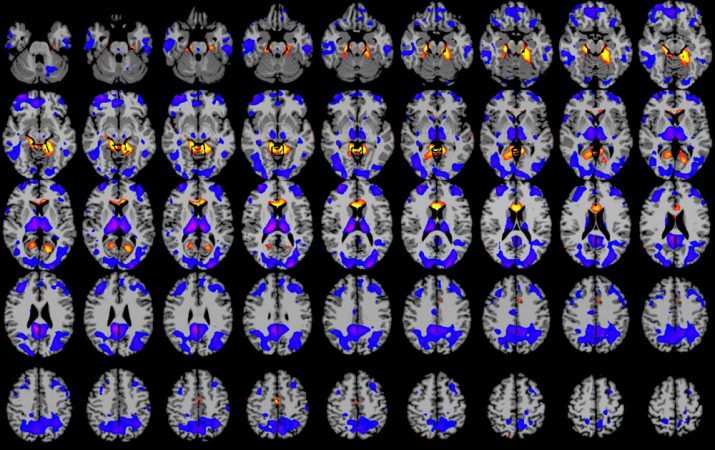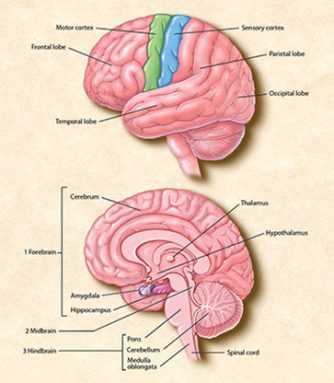No ordinary zzz’s
Anesthetics can put you in a coma — but that’s a good thing
By Susan Gaidos

There you are on the operating table. A doctor is yanking away at your tonsils with a sharp, pointy object, but you don’t feel a thing. After the surgery, you’re rewarded with a heaping bowel of ice cream, but you can’t recall any details of the procedure.
In fact, the last thing you remember is the doctor giving you medicine and telling you that it would make you “sleep.” But did you really snooze through the surgery?
Well, no — not exactly. It turns out that the dreamlike state that patients experience during surgery isn’t really sleep — at least not the kind you do every night. Patients going into surgery are given a mixture of medicines called general anesthetics to keep them from feeling any pain. The medicines numb the entire body, including the brain.
One of medicine’s greatest mysteries is how the drugs work together in the brain to create the pain-free state known as anesthesia (AN ez THEE zha). Recent studies of anesthesia show that the brain doesn’t react like it’s sleeping at all. Instead, patterns of brain activity look more like those of people in a coma.
Sound scary? Don’t panic. Anesthesia’s effects are completely reversible. Doctors, called anesthesiologists (AN ez THEE zee oll a jizts), monitor patients’ health throughout an operation and wake them when it’s over.
But scientists are trying to learn more about how the brain responds under anesthesia. Their research may lead to new and better types of drugs for surgery. The findings may also lead to treatments for people recovering from true comas.
Other research is probing how the brain responds under anesthesia to learn about human consciousness — the state of being fully awake and assembling a memory and understanding of experiences.
What is anesthesia?
Anesthetics are medicines that doctors give to make people feel comfortable during surgery, stitches or other procedures that might be painful. There are two types: general and local. A local anesthetic is applied onto or injected into portions of the body where a painful procedure will occur. When you get stitches, for example, a local anesthetic numbs the area around the gash. So when the doctor sews the skin together, you don’t feel anything.

“Local anesthetics are almost always given just under the skin, right next to a nerve,” says Emery Brown, an anesthesiologist at Massachusetts General Hospital in Boston. The drugs prevent a nerve from sending messages to pain centers in the brain. Because the numbing occurs only at the site of surgery, patients remain awake.
General anesthetics act on the entire body. These drugs block activity in all types of nerve cells, including those that carry pain signals and those that relay sensory information like sights and sounds to the brain. General anesthesia also acts on nerve cells that coordinate movement; this keeps the body still during surgery.
Scientists know a lot about how these drugs work on the body. They know how much is needed to keep patients calm and to eliminate pain. They also know exactly where and how each drug grabs onto nerve cells in the brain and spinal cord, locking out signals that relay pain messages.
But scientists don’t know everything about how anesthesia works. “At this point, one of the big questions is how do the various regions of the brain respond when a patient goes under, or comes out of, anesthesia,” Brown says.
To understand how various drugs work in the brain, Brown and his team at Massachusetts General Hospital put a group of healthy participants under general anesthesia. Instead of going into surgery, these volunteers went inside a machine that uses a powerful magnetic field to show researchers which brain regions are active. (This machine performs what’s called functional magnetic resonance imaging, or fMRI.)

The scientists wanted to see which brain areas the drugs turn on. Nicholas Schiff, a doctor at Weill Cornell Medical College in New York City, reviewed these studies. He says the data show that these medications slow the activity of brain cells, or neurons, and alter their patterns of communication.
Pillow talk
Normally, neurons yak away endlessly. They send messages from one area of the brain to another in the form of tiny electrical pulses. This process continues around the clock. Even while your body is relaxing at night, your brain is still jabbering away. Messages relayed back and forth lead the brain through a complex, predictable routine, called a sleep cycle. During a typical night, the brain may go through four to five such cycles.
In each cycle, the brain alternates between two distinct states: REM — or rapid eye movement — and non-REM sleep. People dream during REM sleep. But their bodies can’t move. In non-REM sleep, breathing and brain activity slow, but people can still move about.
Each stage of the sleep cycle is carefully controlled by the patterns of chatter between groups of neurons. As sleep moves from one stage to another, certain brain cells turn on or off, controlling the duration of that phase.
General anesthesia alters the brain’s chitchat. Instead of continuing its normal chatter, the brain quiets down. In some cases, Schiff says, whole groups of neurons will go totally “silent.”

Two key parts of the brain change their conversations with each other. They are the cerebral cortex and the thalamus. The cerebral cortex is the wrinkled layer of nerve cells that covers the surface of a part of the brain called the cerebrum. It plays a major role in attention and information processing. The thalamus is a ball of tissue at the center of the brain. It acts as a traffic cop to direct the flow of sensory information into the brain.
Under normal circumstances, these two regions continuously pass signals between each other to make sense of what a person sees, hears and feels. When these areas stop communicating, signals from the outside world can’t get through. That’s why the sights and sounds of the operating room — even pain — won’t register with a patient.
“The cells don’t stop functioning altogether, but they stop communicating in a way that allows consciousness and the kind of information processing that we associate with a wakeful state,” Schiff explains.
Sleep is also a state that has unconsciousness, but it’s dynamic, he adds. When you sleep, your brain goes through different stages of the sleep cycle.
Instead of looking like sleep, the quiet brain patterns seen during anesthesia resemble those found in coma patients.
A coma is a state of deep unconsciousness. People who get hit hard in the head or suffer a brain injury may go into a coma naturally. Patients having heart attacks may also slip into a coma if the brain is without oxygen for too long.
Although the anesthetized brain looks similar to a brain in coma, there is a key difference, Schiff says. “Anesthesia is completely reversible.” Patients going under general anesthesia can quickly wake when the surgery is over. But it may take long periods of time before coma patients wake up on their own. Some never do.
Future considerations
Scientists are now investigating other questions about how the brain operates under anesthesia. Their studies may help determine the order in which specific brain cells go mute or begin chattering again as patients move in and out of consciousness.
“By understanding how various parts of the brain change their ability to communicate under anesthesia, we might think of ways to make that process more effective or faster,” Schiff says.
This could lead to entirely new ways of creating pain-free states for patients going into surgery, he says. For example, in the future doctors may rely on Star Trek-like devices that use energy fields, rather than drugs, to disrupt communication within the brain’s electrical circuitry. Scientists working on such a scenario say patients wouldn’t need to take any type of medication at all.
Knowing how the brain responds under anesthesia may help scientists make progress in other areas, too. For example, such studies might help researchers develop new ways to help wake coma patients because the process is similar to coming out of general anesthesia, Schiff says. In fact, he is already using certain anesthetics to help people come out of comas.
The studies might also offer ideas on how to help people suffering from sleep disorders, Brown adds. “We would eventually like to design general anesthesia so that we can control its effects in the brain and central nervous system very precisely,” he says.
Once scientists can precisely control anesthesia, they should be able to adapt those ideas to develop better ways to help people get a good night’s sleep.
Power words
anesthesia A condition in which there is a loss of feeling or consciousness.
anesthetic A drug, gas or other substance that causes a numb feeling in a part of the body or a complete loss of consciousness.
coma A state of deep unconsciousness from which a person cannot be aroused.
nerve A bundle of fibers that carry messages between the brain or other parts of the central nervous system and the eyes, muscles and others parts of the body. Nerves form a network of pathways for sending information throughout the body.
cerebral cortex A brain area involved in many complex functions, including memory, perceptual awareness, thinking, language and consciousness.
thalamus A brain area that receives sensory information and relays this information to the cerebral cortex.
functional MRI Also known as fMRI, it’s a special type of magnetic resonance imaging that uses a strong magnetic field to track brain activity by monitoring blood flow, telling researchers which brain regions are active.
neuron: A specialized cell that transmits nerve impulses. It’s also known as a nerve cell.
Word Find (click here to print puzzle)








